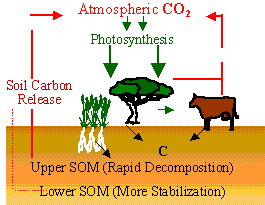Linkages between Climate Change and Desertification: Tschakert
![]() No. 49, May/June 2001
No. 49, May/June 2001
Linkages between Climate Change and Desertification:
Tschakert
 Source: Tschakert 2000 |
Carbon sequestration in soils suggests that fluxes or movements of carbon from the atmosphere can be increased while the natural release of carbon back into the air can be reduced. By absorbing carbon instead of emitting it, soils could evolve from carbon sources to carbon sinks. This process relies on respiration and photosynthesis, two basic processes of the carbon cycle. Carbon, entering the soil in form of roots, litter, harvest residues, and animal manure, is stored primarily as soil organic matter (SOM). In undisturbed environments, balanced rates of input and decomposition determine steady state fluxes. However, in many parts of the world, agricultural and other land use activities have upset this natural balance, thereby releasing alarming rates of carbon to the atmosphere. |